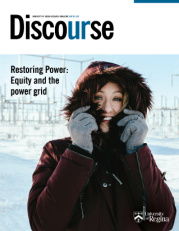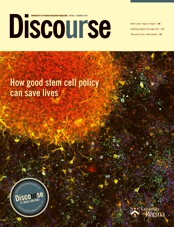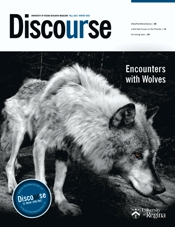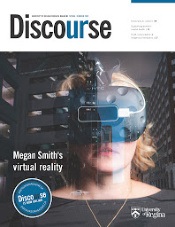Some of our best and brightest minds meet Regina’s business community.

Today, eight international students from the University of Regina were front and centre as they showed off off their leading-edge research at Global Connections: International Students Showcase, a luncheon presented in partnership with the Regina and District Chamber of Commerce.
The event provided an opportunity for members of the Regina and district business communities to meet and connect with some of the brightest minds working in research at the University. It also gave them a chance to network with international students who are preparing to graduate and are looking for employment and partnership opportunities.
Meet these talented students and find out more about their research:
Pradeep Barman is a first year graduate student in the anthropology department in the Faculty of Arts. Barman's research is titled, The Pack’s Purpose: An Inquiry into Canine Intimacies of the Canadian North.
"Through my research I plan on delving into how humans and dogs communicate with one another in a mushing context, where all beings involved understand and work towards a shared objective as athletes.

"I also plan to look at their interaction with other wild animals that they may encounter during training and competition. Finally, I want to elaborate on perceptions around non-human knowledge in shared spaces and the resulting responsibilities."

Zhora Zahir is a PhD candidate in biology in the Faculty of Science. Zahir's research is titled, The Mystery of High Methylmercury Concentration in Prairie Wetland Ponds.
"I am studying methylmercury (MeHg), a highly toxic form of mercury that harms living organisms and their nervous systems.
"MeHg is a dangerous pollutant that accumulates in the food chain, particularly in fish and wildlife. Prairie wetland ponds, both natural and human-made, are crucial habitats for many plants and animals. These ponds have varying levels of MeHg, and my research aims to understand the factors influencing mercury transformation in these ecosystems.
"By monitoring water and soil samples, I am investigating how environmental factors, microbes, and organic carbon interact in these ponds. Our findings will inform policies and practices to protect the health of wetland ponds and the species that depend on them."
David Akinmade is a graduate student in the Faculty of Science. His research is entitled, Language Artifical Intelligence: The Past, Present and our Future.
"When your phone corrects your grammar as you type a message, or when ChatGPT answers a question for you – this is language artificial intelligence at work. It’s amazing technology, but it has a major flaw.

"When a question is asked about a topic that the AI has little to no information about, the system tends to falsify information. This is a problem, as these responses can be misleading.
"My research focuses on using text classification to teach an AI system to understand how to detect fraudulent information within Twitter conversations. By showing the system a mixture of honest and scam conversations, it learned how to distinguish both, and also improved the system’s response to questions about social-media related fraud.
This technology could also be used to identify fake news or misinformation, or could even be taught how to conduct research for legal cases. As long as the task is performed primarily through the use of language, it can be learned by the AI system."

Zohra Bahrami is a fourth year undergraduate student in the Faculty of Social Work. Her presentation is entitled, Powered by Twitter? Taliban's Takeover of Afghanistan.
"In recent decades, social media has become a central aspect of our daily lives. To better understand the harms inflicted by social media, my research looks at the Taliban’s use of social media in the six months prior to its takeover of Afghanistan on August 15, 2021.
"Drawing on tools created by the University of Regina’s Center for Artificial Intelligence, Data, and Conflict (CAIDAC), I used artificial intelligence-supported tools to map the Taliban’s social media ecosystem, which includes more than 126,000 Taliban-affiliated accounts, along with two million Twitter posts.
"The research identified six key information campaign strategies used by the Taliban in the months prior to the takeover of Afghanistan, including the Taliban identifying themselves as a government-in-waiting and making false claims of victory. Further, misogynistic ideologies and misogynistic imagery were used by the Taliban to shape the Afghans perception of the Taliban and the Afghan government.
"With social media at their fingertips, Taliban now have access to different platforms aiding them in the transfer of their ideologies to the next generation of Afghans."
Rupinder Arora just graduated with Bachelor of Applied Science in electronic systems engineering. Her presentation is, Harmonics Metering Device.
"Power systems are a network of electrical components used to supply, transmit, and consume electric power. They are designed to operate at a frequency of 60 hertz (Hz).

"However, certain types of equipment produce currents and voltages with frequencies that are much higher than this. These higher frequencies are a form of electrical pollution known as power system harmonics. Higher levels of current harmonics can have a significant impact in an electrical system.
"Most equipment in an electrical system does not have the ability to withstand extreme temperatures. Harmonics, which can cause extreme temperatures, can be damaging.
"I have designed a cost-effective Harmonics Metering Device (HMD) to determine the harmonics that significantly affect the electrical unit we are using for testing. In this case, when current harmonic levels exceed normal operating conditions, an alarm within the HMD provides a visual indication to the personnel at the University of Regina. Once the cause of the excessive current is identified, personnel will initiate troubleshooting steps to rectify the issue. Additionally, the HMD can be used to monitor existing equipment to improve overall efficiency and to aid in the designing filters for the unwanted frequencies."
Ali Usman is a graduate in the physics department in the Faculty of Science. His work is entitled Capturing the Light – U of R Physicists at the Forefront of Cutting Edge Technology Development in Subatomic Physics
"My research is focused on understanding the structure of subatomic particles, like a proton.

"I work on the design and construction of sophisticated experimental equipment used to conduct experiments at internationally reputed physics labs. I then use high-performance computing to analyze the experimental data before comparing the results with theory predictions.
"The goal of this research is to understand how the universe behaves at the fundamental level and therefore to solve fundamental questions in subatomic physics."

Surya Pusapati is a recent graduate of the master's of applied science in the industrial systems engineering program. Her project is called Simulation of 5G-NR Vehicle to Cellular Network in Downtown Regina.
"The fifth- generation of telecommunication has standardised several technological advancements, and vehicle-to-cellular network communication (V2N) is one of them.
"With reliable connectivity, V2N makes advanced driving, extended sensors, and remote driving possible.
"My research will centre on the downtown area of Regina, which will be simulated with V2N to analyse the network performance. To improve the performance of V2N with a massive number of vehicles connected to the network, the resource management system must efficiently allocate resources in a timely manner. With the help of machine learning and the simulated dataset, Network KPI Prediction models are developed to assist resource management systems."












